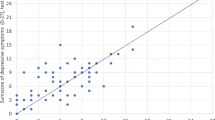Abstract
Introduction
We developed the Brief Scale for Psychiatric problems in Orthopaedic Patients (BS-POP) (doctor and patient versions). The present study aimed to proactively verify the factorial validity, internal consistency, criterion-related validity and reproducibility of the BS-POP with regard to chronic low back pain patients.
Methods
Subjects comprised 193 chronic low back pain patients. During the first test, the BS-POP, Minnesota Multiphasic Personality Inventory (MMPI), Profile of Mood States (POMS) and 36-Item Short-Form Health Survey version 2 (SF-36 v2) were conducted. In the second test, patients were asked to complete the BS-POP in order to verify BS-POP reproducibility.
Results
Factor analysis demonstrated the factorial validity of the BS-POP, including 1-factor structure. Internal consistency was confirmed by Cronbach’s α reliability coefficients of 0.794 (doctor version) and 0.750 (patient version). Criterion-related validity was confirmed through association with the psychosocial factors of the SF-36, the MMPI, and the POMS. The correlation coefficients for the retests were r = 0.654 (doctor version) and r = 0.719 (patient version), showing reproducibility.
Discussion
The present findings indicate that the BS-POP possesses sufficient reliability regarding computational psychology. The BS-POP constitutes a tool enabling orthopaedists themselves to easily identify psychiatric problems in orthopaedic patients. Further study is required regarding responsiveness.


Similar content being viewed by others
References
Andersson GBJ. Epidemiology of low back pain. Acta Orthop Scand. 1988;69:28–31.
Frymoyer JW. Back pain and sciatica. N Engl J Med. 1988;318:291–300.
Andersson GBJ. Epidemiological features of chronic low-back pain. Lancet. 1999;354:581–5.
Croft P, McFlance GJ, Papageorgiou AC, Thomas E, Silman AJ. Outcome of low back pain in general practice: a prospective study. Br Med J. 1998;316:1356–9.
Rush A, Polatin P, Gatchel R. Depression and chronic low back pain. Spine. 2000;25:2566–71.
DeRubeis R, Gelfand LA, Tang TZ, Simons AD. Medications versus cognitive behavior therapy for severely depressed outpatients: mega analysis of four randomized comparisons. Am J Psychiatry. 1999;156:1007–13.
Pincus T, Burton AK, Vogel S, Field AP. A systematic review of psychological factors as predictors of chronicity/disability in prospective cohorts of low back pain. Spine. 2002;27:E109–20.
Larson SL, Clark MR, Eaton WW. Depressive disorder as a long-term antecedent risk factor for incident back pain: a 13-year follow-up study from the Baltimore Epidemiological Catchment Area sample. Psychol Med. 2004;34:211–9.
Currie SR, Wang L. Chronic back pain and major depression in the general Canadian population. Pain. 2004;107:54–60.
Ruddy JL, Meagher MW. The role of emotion in pain modulation. Current Opin Psychiatr. 2001;14:241–5.
Hathaway SR, McKinley JC. Minnesota Multiphasic Personality Inventory manual for administration and scoring. Minneapolis: University of Minnesota Press; 1983.
Zung WWK. A self-rating depression scale. Arch Gen Psychiatry. 1965;12:63–70.
Beck AT, Ward CH, Mendelson M, Mock J, Erbaugh J. An inventory for measuring depression. Arch Gen Psychiatry. 1961;4:248–53.
Hamilton M. A rating scale for depression. J Neurol Neurosurg Psychiatry. 1960;23:56–62.
Radloff LS. The CES-D Scale: a self-report depression scale for research in the general population. Appl Psychol Measurement. 1977;1:385–401.
Sato K, Kikuchi S, Mashiko H, Okano T, Niwa S. Rinshou Seikeigeka (Clin Orthop Surg). 2000;35:843–52 (in Japanese).
Watanabe K, Kikuchi S, Konno S, Niwa S, Masiko H. Brief scale for psychiatric problems in orthopaedic patients (BS-POP) validation study. Rinshou Seikeigeka (Clin Orthop Surg). 2005;40:745–51 (in Japanese).
Fukuhara S, Suzukamo Y. Manual of SF-36v2 Japanese version. Kyoto: Institute for Health Outcomes & Process Evaluation Research; 2004.
Kopec JA, Sayre EC, Esdaile JM. Predictors of back pain in a general population cohort. Spine. 2004;29:70–7.
Garratt AM, Ruta DA, Abdala MI, Buckingham JK, Russell IT. The SF-36 health survey questionnaire: an outcome measure suitable for routine use within the NHS? Br Med J. 1993;306:1440–4.
van der Windt D, Hay E, Jallema P, Main C. Psychosocial interventions for low back pain in primary care. Spine. 2008;33:81–9.
Trescot A, Glaser SE, Hansen H, Benyamin R, Patel S, Manchikanti L. Effectiveness of opioids in the treatment of chronic non-cancer pain. Pain Physician. 2008;11:S181–200.
Verdu B, Decosterd I, Buclin T, Stiefel F, Berney A. Antidepressants for the treatment of chronic pain. Drugs. 2008;68:2611–32.
van Kleef M, Barendse GAM, Kessels A, Voets HM, Weber WEJ, de Lange S. Randomized trial of radiofrequency lumbar facet denervation for chronic low back pain. Spine. 1999;24:1937–42.
Smeets RJEM, Vlaeyen JWS, Kester ADM, Knottnerus JA. Reduction of pain catastrophizing mediates the outcome of both physical and cognitive-behavioral treatment in chronic low back pain. J Pain. 2006;7:261–71.
Linton SJ, Nordin E. A 5-year follow-up evaluation of the health and economic consequences of an early cognitive behavioral intervention for back pain: a randomized, controlled trial. Spine. 2006;31:853–8.
Trief PM, Grant W, Fredrickson B. A prospective study of psychological predictors of lumbar surgery outcome. Spine. 2000;25:2616–21.
Wiltse LL, Rocchio PD. Preoperative psychological tests as predictors of success of chemonucleolysis in the treatment of the low-back syndrome. J Bone Joint Surg Am. 1975;57:478–83.
Flor H, Fydric T, Trurk DS. Efficacy of multidisciplinary pain treatment center: a meta-analysis review. Pain. 1992;49:221–30.
Clark MR. Psychiatric issues in chronic pain. Curr Psychiatr Rep. 2009;11:243–50.
Acknowledgments
We thank the many individuals who participated in the present study and the physicians who provided valuable advice. This study was supported by Research Aid from the Japanese Orthopaedic Association. We declare that we have no conflict of interest regarding the present manuscript.
Author information
Authors and Affiliations
Corresponding author
About this article
Cite this article
Yoshida, K., Sekiguchi, M., Otani, K. et al. A validation study of the Brief Scale for Psychiatric problems in Orthopaedic Patients (BS-POP) for patients with chronic low back pain (verification of reliability, validity, and reproducibility). J Orthop Sci 16, 7–13 (2011). https://doi.org/10.1007/s00776-010-0012-4
Received:
Accepted:
Published:
Issue Date:
DOI: https://doi.org/10.1007/s00776-010-0012-4




